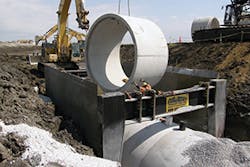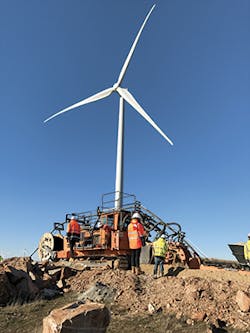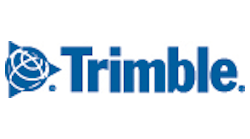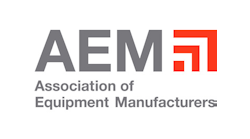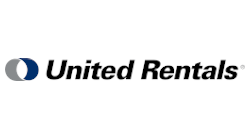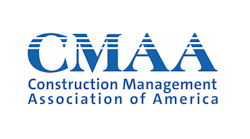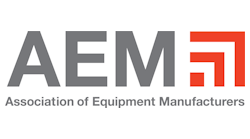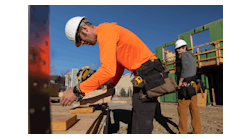Kids building castles in the beach sand have something uniquely in common with contractors putting in sophisticated pipe networks or skyscraper foundations. Whether scraping out the dirt for King Arthur’s moat, or excavating for new municipal infrastructure, both require digging the trench and supporting that pit. The enterprising young engineers will have a sturdy hand shovel and a ready supply of popsicle sticks to shore up their protection from Saxon invaders, but today’s contractors can make quick work of both the hardest ground and awkward tight spots. From massive to mini-sized, the latest trenching machines, along with versatile shoring and trenching systems, make getting the job done faster, and safer and better than ever.
At Union City, MI-based Trinity Shoring Products, spokesperson Tommy Marciniak details their role in trench-shoring markets.
He says that in 1995, Pro-Tec Equipment was founded, and it has enjoyed successful growth in the last 20+ years.
He adds that the company (now a division of Trinity) was the first to include a 4-point lifting system as standard on all trench shields which “increases the speed and safety of loading and unloading the equipment.”
However, Marciniak adds, their latest product launch is the Pro-Tec Equipment 3” Dual Action Manhole shore.
“This is a hydraulic bracing system that is designed to bridge the gap between our Manhole Brace and ProBrace System,” he explains. “It’s dual action because it can work in two- or four-sided applications and can incorporate a variety of sheeting materials. Basically, the bracing looks like sets of modular brackets that can be connected as a square, and this square configuration can hydraulically be expanded to accommodate your size needs.”
He says that the sheeting can be attached on two or all four sides, which gives workers an optimum system for vaults, C.I.P. projects, pump stations, and more.
The Manhole Shore can be used in a four-sided pit or a two-sided trench and is rated for use in spans from 7–24 feet wide and excavation depths that range from 9–28 feet, depending on lateral pressure.
Marciniak adds that as lateral pressure increases with depth, this places limitations on both excavation equipment and shoring units. “The deeper the excavation, the more side pressure is exerted, which means you need to go to heavier support systems.”
Pro-Tec Equipment came to the rescue for Chicago-based contractor James McHugh, whose company had to install 84-inch reinforced concrete as part of the Westbound I-290 Flyover Project. Pro-Tec Equipment Shoring manager Joshua Thorne says that initially, the Slide Rail was considered by the limitations of being within 5 feet of active traffic for both the receiving and jacking pits, as well as having a building 65 feet from the receiving pit necessitated a different solution. Thorne adds that settlement of the nearby building, roadway, and bridge support, and many active utilities posed concern for local officials, mandating that “any shoring used could deflect no more than one.”
Tackling the dilemma of this tight fit meant “only one thing could be done,” recalls Thorne. And this meant sheeting in the form of Pro-Brace, a series of enclosed hydraulic rams and static extensions.
“Pro-Brace is different from traditional cut-and-weld style, whose system design benefits projects by being a quick installation that can be used in irregular shapes, with each ram hydraulically pumped into position. Plus, these can be staged on top of each other to hasten installation time, which is vital while working in the middle of a cold Chicago winter,” says Thorne.
While the system was a bigger investment, the project manager confirmed that the savings from Pro-Brace in terms of labor savings compared to a traditional cut-and-weld or beam-and-lag job, “more than made up for it.” The Pro-Brace system allowed the tunneling crew to successfully excavate 895 feet for the pipe installation in 6 weeks. Progress of nearly 30 feet per day within these tight limitations, performed in the middle of winter, made believers out of all crew involved.
Making Quick Work of Big Projects
According to marketing manager Joshua Hill, Tesmec USA was established in 1984 as a company specializing in the design and manufacture of trenchers that have the capacity to dig trenches for energy-cable laying in addition to pipelines. He says that the US branch of Tesmec—currently headquartered in greater Dallas, TX—has seen a trajectory of global success building off of those first innovations in Italy.
“With mergers and acquisitions, we now have six production facilities, with four in Italy, one in the US, and one in France—the last facility, known as Marais, which is our most recent acquisition that manufactures microtrenchers such as the Sidecut SC3C. This new unit is perfect for dense urban areas found across those cities that pose access challenges to infrastructure work.
“Our bulky machines can’t really go underground in tight spaces, but these can. Plus, they are perfect for dense urban spaces when you have to actually dig the hole in the road from the sidewalk. If you use a directional drill, there is a lot of setup time and mess, and these microtrenchers are great for neighborhoods—especially for installing fiber optic networks that are a delicate process compared to laying pipe. You can get in, do your work, and get out even before the neighborhood residents know you’ve even been there.”
Hill says the large units, made in the US, are built for tough jobs “out in the wide open spaces.”
“These are massive trenchers and they can weigh up to 330,000 pounds and with a capability to cut a trench swath up to 72 inches, they make short work of what used to be labor-intensive projects. However, the largest machines are so large they have to be taken apart into three sections to be shipped,” explains Hill.
These big trenchers “dig a better trench than excavators as the pit sides are flat and parallel, so depending on the situation, there can be less need for shoring.”
He cites one of their latest innovations that speeds up the installation of windfarm or other cable systems: the Mechanical Laying process developed by Marais.
“We have a reel carrier that carries up to three 20-ton reels of cable, a wrapping machine, and a trencher that lays the cable all in one process. The Marais ST2 trencher digs the trench, lays it down in the trench, and as it passes over, then covers it back up with dirt—this is an incredible labor- and time-saving process. Another benefit is that with one machine, you are reducing your carbon footprint and bringing less impact to the environment,” adds Hill.
When excavation gets into harder rock, like granite, Hill says that their rock saw machines “can cut through rock like butter.”
“If you run into hard rock like granite, you can use this giant rock saw and it just cuts right through. Sometimes, in really hard rock environments, these machines are used to cut a pilot trench and then come back and widen it.”
He says the phenomenal capabilities of their machines were once featured in a televised segment that showcased how easily they can take on the toughest jobs.
But Hill emphasizes the efficiency of the machines. Not only are they labor-saving, but a job site with fewer people and machines reduces operations risks and creates a safer work environment.
Moses Would Have Liked This
Calling their products the “Go-To Source” for the industry’s shoring equipment solutions, James McRay says “Our name, Efficiency Production, is what we do; our motto, ‘America’s Trench Box Builder,’ is what we are.”
He says the Mason, MI-based firm manufactures an extensive line of trench shields, boxes, rails, and walls.
“In one scenario, the Sewer District of Riverdale, UT, was plagued with repeated cracks and leaks occurring in their sewer line that ran under the swift current of the Weber River. After a diver assessed the situation, the contractor decided to dam the river, enabling the workers to do repairs unencumbered. But instead of using an expensive cofferdam system, they chose our trench box system which was much more cost-effective.”
He says that after a bypass channel was dug and shored, four 8- by 20-foot trench boxes with 84-inch spreaders were set upstream and then filled with dirt to create a solid cofferdam. But it didn’t stop there.
“They had to control the flow of water through the diversion channel of the empty box channel, and there was concern that the water flow pressure at 1350 cfs well exceeded its rating, but the boxes held up with no problems,” reports McRay.
“In eight weeks, the crew cut the bypass channel, dammed the river, and completed the work to the pipeline system, backfilling and diverting the 525 feet of river back to its original course. To say it was an impressive feat of ingenuity is an understatement.”
McRay says that “One thing that has made a difference is our slide rail system. By taking the steel sidewall of the trench shield, they can be put together into a series of panels sliding together and can be changed to a different size, depending on the size and depth of the excavation.
“Before, if you wanted to go to 30 feet, you had to stack four-sided trench shields, and it just got heavier. And then you needed heavier equipment to move it all into place. With a slide rail, a regular Cat 35 can lift the panel and post. There’s a lot of flexibility to this system,” he explains.
The terminology of shores and shields, often used interchangeably, is actually very specific. “While the shields are the protection against the dirt, the shores are the hydraulic system, made of aluminum that you install against the shields, and are designed to pump with pressure against the rails on the opposite side. This creates an arcing effect and prevents side collapse.
“The main advantage is these are lightweight and can be installed by hand and activated from outside the trench. In essence, you scissor the shore open, put it into position, and then handpump the shoring fluid until they reach maximum pressure,” says McRay.
“We work with our customers from beginning to end to make it super easy. They might come to us and say, ‘Hey, I need to put in an 8 feet length, 6-inch diameter pipe at 16 feet deep. Tell us what we need, what excavator to use,’ and then we’ll tell them which box to use. You have to have a certain size box that meets its depth rating. Plus, for our slide rail system, we have a whole department called Special Operation Shoring Division, and these are our experts who actually go out with the customer to make sure they get exactly what they need to for the job, and to comply with safety.”
The big steel for trench box shields, rails, and components can weigh 40,000 pounds and requires an excavator to lift them into place. “Other than that, we provide all the tools, slings, shackles to angles, all in a job box so you have the tools ready at hand to install. We also have a proprietary ground release shackle so that by pulling a rope, you do not have to climb a ladder to release this piece from the unit. The job box also has tools to help you space the pieces correctly, and a corner tool so you can check to make sure it is square. We’ve done thousands of slide rail systems, so we know what guys need.”
When contractors bid a job, they may need to tell the local DOT what they are using and that it’s in compliance with the respective pressures exerted in the trench.
“Our Special Ops shoring guys will help you manage all these variables,” says McRay. “So for example, if you are doing a storm sewer next to I-94, we can do CAD drawings to show how the shoring will work, how it meets the pressures from the depths you are excavating, and you can take this to the DOT as part of your bid.”
In fact, the company did just that for a complex installation at Chicago’s busy O’Hare Airport. This project, designed to update and streamline one of the world’s busiest airports, involved reconfiguring runways, removing buildings, and transforming outdated systems to reduce flight delays and increase capacity for the future. However, updating the underground utilities was an endeavor of its own, and the new stormwater system required installation of 188 pipe sections that were each 144 inches in diameter. In other words, 15,000 line feet, or more than 5 miles, needed to go 25 feet below the future runways. To handle the job, Efficiency leveraged their experience in unconventional solutions and designed the trench shields to stack on each other and modified the spreader arch to allow more clearance than conventional steel pipe. They safely allow for the installation of two large precast junction boxes along the pipeline. Efficiency designed and helped assemble onsite a second set of stacked trench shields with spreader arches on both ends.
Efficiency Productions’ custom install at Chicago’s O’Hare Airport
At the Special Ops Division, manager of shoring operations specialist Mike Ross underscores the benefits of collaboration.
“Everything is built with a goal, and while many companies separate productivity and safety, we tie them together. It’s a simple premise: dig efficiently, keep dirt out of the way, stop cave-ins, and the end product translates to efficient production is safe production,” he says.
“In our division, we have dedicated draftsmen that can give you a dimensional picture of what you need to use and remain compliant with OSHA.”
Ross adds that the fines are stiff for working without a trench box. If the compliance officer finds that there is no box in the hole with risk of a cave-in, this can cost plenty, and the fines double for each occurrence.
A Twist on the Usual
“Unlike everyone else in this industry, we were a distributor before we were a manufacturer, “ says Michael Plank, Chairman and CEO of Houston, TX-based Speed Shore Corporation, “and this gives us a unique perspective of both our market and the customer.”
He says their sister company, The Plank Company, an underground equipment specialist, was at one time the largest distributor of trenching and shoring equipment, but was sold in 1999, eventually becoming part of the United Rentals network.
Simultaneous trenching and cable laying
“There are two distinct kinds of devices: shoring, which actively puts pressure on the wall, and shielding—sometimes called a trench box—which is a blocking device, to protect workers while working inside a trench. As a company, we are all about safety in the environment and we actually helped found the Trench Shoring & Shielding Association (TSSA). This group provides a valuable service to the industry and is very active in Technical & Safety programs,” explains Plank.
The TSSA offers free downloadable brochures on safety information, guidelines of best practices for trench shoring and shielding, and a cost-effective perspective on saving money by using trench shoring and shielding equipment.
While they are a leader in advocating trench safety, perhaps their most notable market contribution was as “the originator of the aluminum shoring system, and originator of the aluminum concept which now represents half the industry,” affirms Plank. Aluminum foam-filled panel shields have walls with rugged steel lifting and pulling eyes that give customers a versatile solution both in minimal weight, yet having exceptional strength, perfect for light excavator work.
“We often work with the distributor of our products to assist in providing site-specific engineering for customers. Our operational attributes are the best there is and we take great pride in how our systems are designed to be safely installed and removed from above the ground. No one is in harm’s way before it’s installed, nor while the systems are being removed. And the hydraulics can be pumped to the needed levels prior to lowering into the pit; everything is truly done in the safest possible manner.”
Plank further adds that as risks are lowered through these built-in safety measures, they also help to lower your insurance rates.
“Many people misuse a box and trench shield system, more often due to unfamiliarity with what these units are designed to do, and in the belief that shielding can act as shoring protection. But, it’s essential to know the challenges of the respective trench, the pressures from the soil depths, and then choose the system that is rated to meet that need. Shielding is one thing, shoring something else entirely.”
He further adds that they played a critical role in helping the market understand their needs.
“We helped develop the manufacturer’s tabulated data (MTD) that the industry uses now, and this allows us to certify what systems can do, and what application each one is best suited for. The MTD gives latitude on how to use a system, and how to choose, for example, a higher grade aluminum for additional strength which can stretch the use of their product in the field.”
